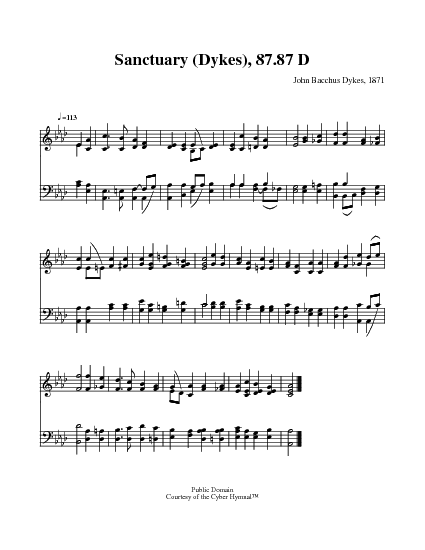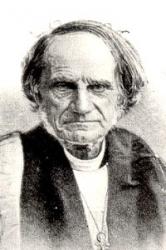- |
User Links
Hark! The Sound of Holy Voices

Hark! the sound of holy voices, Chanting over the crystal sea
Author: Christopher Wordsworth (1862)Published in 235 hymnals
Printable scores: PDF, MusicXMLAudio files: MIDI
Representative Text
1 Hark! The sound of holy voices,
chanting at the crystal sea:
alleluia, alleluia,
alleluia, Lord, to thee:
multitude, which none can number,
like the stars in glory stands,
clothed in white apparel, holding
palms of victory in their hands.
2 Patriarch and holy prophet,
who prepared the way of Christ,
king, apostle, saint, confessor,
martyr and evangelist,
saintly maiden, godly matron,
widows who have watched to prayer,
joined in holy concert, singing
to the Lord of all, are there.
3 They have come from tribulation,
and have washed their robes in blood,
washed them in the blood of Jesus;
tried they were, and firm they stood;
gladly, Lord, with thee they suffered;
gladly, Lord, with thee they died,
and by death to life immortal
they were born, and glorified.
4 Now they reign in heavenly glory,
now they walk in golden light,
now they drink, as from a river,
holy bliss and infinite;
love and peace they taste for ever,
and all truth and knowledge see
in the beatific vision
of the blessèd Trinity.
5 God of God, the One-begotten,
Light of Light, Emmanuel,
in whose Body joined together
all the saints for ever dwell;
pour upon us of thy fullness,
that we may for evermore
God the Father, God the Son, and
God the Holy Ghost adore.
Source: CPWI Hymnal #827
Author: Christopher Wordsworth
 Christopher Wordsworth--nephew of the great lake-poet, William Wordsworth--was born in 1807. He was educated at Winchester, and at Trinity College, Cambridge, where he graduated B.A., with high honours, in 1830; M.A. in 1833; D.D. in 1839. He was elected Fellow of his College in 1830, and public orator of the University in 1836; received Priest's Orders in 1835; head master of Harrow School in 1836; Canon of Westminster Abbey in 1844; Hulsean Lecturer at Cambridge in 1847-48; Vicar of Stanford-in-the-Vale, Berks, in 1850; Archdeacon of Westminster, in 1865; Bishop of Lincoln, in 1868. His writings are numerous, and some of them very valuable. Most of his works are in prose. His "Holy Year; or, Hymns for Sundays, Holidays, and other occ… Go to person page >
Christopher Wordsworth--nephew of the great lake-poet, William Wordsworth--was born in 1807. He was educated at Winchester, and at Trinity College, Cambridge, where he graduated B.A., with high honours, in 1830; M.A. in 1833; D.D. in 1839. He was elected Fellow of his College in 1830, and public orator of the University in 1836; received Priest's Orders in 1835; head master of Harrow School in 1836; Canon of Westminster Abbey in 1844; Hulsean Lecturer at Cambridge in 1847-48; Vicar of Stanford-in-the-Vale, Berks, in 1850; Archdeacon of Westminster, in 1865; Bishop of Lincoln, in 1868. His writings are numerous, and some of them very valuable. Most of his works are in prose. His "Holy Year; or, Hymns for Sundays, Holidays, and other occ… Go to person page >Text Information
| First Line: | Hark! the sound of holy voices, Chanting over the crystal sea |
| Title: | Hark! The Sound of Holy Voices |
| Author: | Christopher Wordsworth (1862) |
| Meter: | 8.7.8.7 D |
| Language: | English |
| Copyright: | Public Domain |
Notes
Hark, the sound of holy voices, chanting at the crystal sea. Bishop C. Wordsworth of Lincoln. [All Saints' Day.] First published in his Holy Year, 1862, No. 106, in 6 stanzas of 4 double lines (5th ed. 1868, No. 109). In 1863 it was given in the Parish Hymn Book, No. 190, and subsequently in other collections, until it has become throughout all English-speaking countries one of the most widely known and popular of the Bishop's hymns. In some collections stanza ii., line 2 is given as in the original:—
“King, Apostle, Saint, .and Martyr, Confessor, Evangelist,"
and in others:—
" King, Apostle, Saint, Confessor, Martyr, and Evangelist,"
The reason for this change is twofold: first, because of the division of the original line into two, and second, possibly because the old distinction between Confessor—i.e. one who witnesses for the faith by a good confession short of actual martyrdom; and Confessor, i.e. one who receives confessions—was beyond the comprehension of ordinary congregations. One of the first, if not the first collection in which this change was made, was the Appendix to Hymns Ancient & Modern, 1868.
In the Society for Promoting Christian Knowledge Church Hymns, No. 199, stanza v. is bracketed for omission in singing if desired. This stanza reads:—
“Now they reign in heavenly glory, now they walk in golden light,
Now they drink as from a river, holy bliss and infinite
Love and Peace they taste for ever; and all truth and knowledge see
In the beatific vision of the Blessed Trinity."
The Rev. J. Ellerton's note on this hymn in his Notes, &c, on Church Hymns, folio edition, p. xlviii. explains this arrangement as follows
“In the earlier editions of Church Hymns the fifth stanza of this hymn, ‘Now they reign in heavenly glory,' &c, was omitted in deference to the judgment of one of the Episcooal Referees of the Society for Pro¬moting Christian Knowledge, who held that the verse was liable to be misunderstood as countenancing the papular error that the Blessed are already in the full fruition of their future and everlasting glory — the ‘Beatific Vision.' It is scarcely needful to say that so accurate a theologian as the Bishop of Lincoln had no sympathy with this view. His Lordship, while pressing for the restoration of this verse, explained that the whole hymn, from beginning to end, was to be regarded as the utterance in triumphant song of a vision of the final gathering of the saints, not as an exposition of their present condition in the Intermediate State. The Tract Committee of the Society therefore desired that the verse should in subsequent editions be restored; but should, in deference to those who might still think it liable to misconstruction, be bracketed for optional use."
In a manuscript note on this hymn, and this special stanza, Bp. Wordsworth adds that:—
"The whole hymn from beginning to end is in harmony with the Epistle for the festival of the day (Rev. ii. 2, &c), and like it is the utterance in triumphant
song of a vision of the final gathering of the Saints." [E. MSS.]
It may be added that, with the exception of the alteration noted above, the original text of this hymn is usually given in an unaltered form.
--John Julian, Dictionary of Hymnology (1907)


 My Starred Hymns
My Starred Hymns





